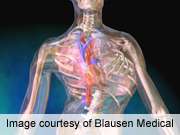Adolescents with untreated adolescent idiopathic scoliosis report worse pain and worse self-image than unaffected adolescents, although the difference is clinically significant only for self-image, according to a review published in the April 20 issue of Spine.
(HealthDay)—Adolescents with untreated adolescent idiopathic scoliosis report worse pain and worse self-image than unaffected adolescents, although the difference is clinically significant only for self-image, according to a review published in the April 20 issue of Spine.
Paul R.P. Rushton, M.R.C.S.Ed., and Michael P. Grevitt, F.R.C.S. (Orth.), from the Queen's Medical Centre in Nottingham, U.K., identified and reviewed 15 published studies with 21 patient cohorts evaluating health-related quality of life in adolescents with untreated adolescent idiopathic scoliosis.
The researchers found that although 81 percent of affected cohorts reported statistically more pain than unaffected individuals the difference was clinically significant in only 5 percent of cohorts. Of 11 cohorts examining patient self-image, 91 percent reported statistically worse scores in the affected than the unaffected, and the difference was clinically significant in 73 percent of cohorts. Affected cohorts scored well on function/activity and mental health domains, and the differences from the unaffected were rarely clinically significant.
"Pain and self-image tend to be statistically lower among cohorts with adolescent idiopathic scoliosis than those unaffected," Rushton and Grevitt conclude. "The literature to date suggests that it is only self-image which consistently differs clinically. This should be considered when assessing the possible benefits of surgery."
More information:
Abstract
Full Text (subscription or payment may be required)
Journal information: Spine
Health News Copyright © 2013 HealthDay. All rights reserved.
























